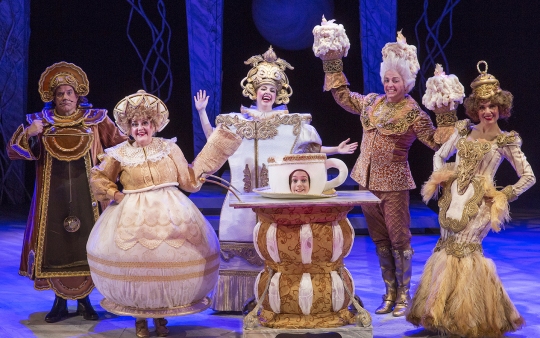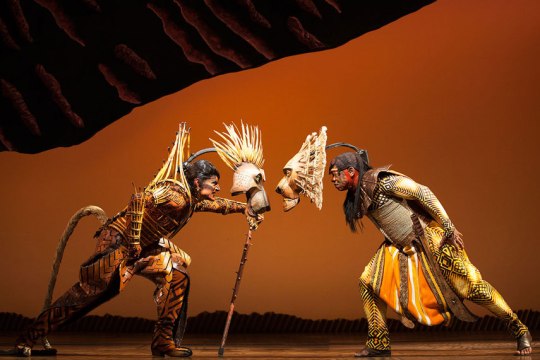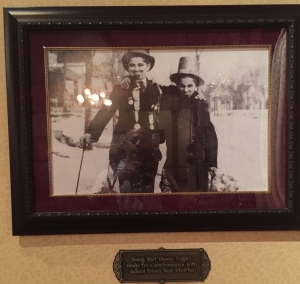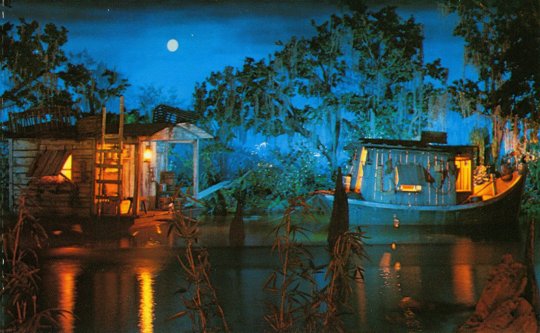Disney Banks on Broadway
 I wonder whether Walt Disney, who made his fortune first in film, might have foreseen a time when his company would be one of the world’s most prolific and successful producers of theater musicals?
I wonder whether Walt Disney, who made his fortune first in film, might have foreseen a time when his company would be one of the world’s most prolific and successful producers of theater musicals?
Walt certainly had theater in his thoughts when he went to work on Disneyland. But, more on that later. In the meantime, Disney is about to open its new production of Frozen on Broadway.
I’m a big fan of live theater. Unlike movies or television, a theater experience is unique in that each performance has the potential to be a different experience, for the audience and the performers. Stage actors have to give a polished performance eight or more times a week. In order not to get bored and loose the energy that each audience expects, good actors try to “be in the moment”. Yes, they know their lines and where they are supposed to be at different points of any scene. But, each time through, actors will try not to simply duplicate their performance. They listen to the other actors and react in real time, not changing the words, but often changing how the words are spoken. One night, perhaps a line is said in great anger. Another time, that same line might sound merely annoyed. I can tell you as a former actor that there is nothing more exciting and satisfying as finding yourself “in the moment” on stage when something organic happens in a scene that hasn’t happened before or doesn’t happen all the time. Theater not only makes the actors think, but often challenges its audiences to do the same.
 Any discussion of Disney Theatrical Productions (Disney on Broadway) has to include the impact that it’s had on New York City. Following the success of of Beauty and the Beast in 1993, Disney jumped in with significant energy and money. They not only produced their most successful Broadway musical, The Lion King. But they agreed to 99 year lease on a theater that no one wanted and to give a share of the profits back to the City. They they completely restored it to its early 20th century glory. Many would argue that Disney’s investment, not only paid off for them, but led to a commercial and tourist renaissance for the Great White Way, which runs from 42nd street where Disney’s New Amsterdam Theater sits, up to 53rd St. and includes Times Square.
Any discussion of Disney Theatrical Productions (Disney on Broadway) has to include the impact that it’s had on New York City. Following the success of of Beauty and the Beast in 1993, Disney jumped in with significant energy and money. They not only produced their most successful Broadway musical, The Lion King. But they agreed to 99 year lease on a theater that no one wanted and to give a share of the profits back to the City. They they completely restored it to its early 20th century glory. Many would argue that Disney’s investment, not only paid off for them, but led to a commercial and tourist renaissance for the Great White Way, which runs from 42nd street where Disney’s New Amsterdam Theater sits, up to 53rd St. and includes Times Square.
I wrote about a D23 event to celebrate the 20th anniversary of Disney’s New Amsterdam restoration in Report on D23’s “Behind the Scenes” NYC Event. Here’s before and after some photos of this beautiful theater

Let’s remember, that as much as we’d like to see Disney as the benevolent doer of good, it’s still a hard driving, money making operation, beholden to stock holders and under constant scrutiny by everyone from Wall St. to blogs like mine and millions of fans around the world. The fact that Disney has accelerated and increased its investment in live musical theater, must mean that it does two things – Makes money and promotes the brand. To date, Disney has produced nine musicals on Broadway.
1993
1997
2000
2006
2007
2007
2011
2012
2018
According to the New York Post, only 1 out of 5 Broadway musicals turns a profit for investors. For those of you who are math challenged, like me, that‘s a paltry 20% success rate. Of the nine Disney musicals that have premiered , five have turned out to be critical and/or box office successes (success being measured by profit or length of run): Beauty & the Beast, The Lion King, Aladdin, Newsies and Mary Poppins. Frozen is scheduled to open this March. Using the properties current success on film, theme parks and merchandise, I think it is safe to say, barring unusual circumstances or a complete failure of marketing, that Frozen will be added to the list of successes. That would make six out of Nine or a 66% success rate. Not even in Walt’s day did the studio make money on that many animated features.
To Disney’s credit, if you go back and look at the timeline, Aida was a failure and there were two failures in a row, Tarzan and Little Mermaid. Since the Lion King has become the most successful production and continued to run, they could have quit there and walked away with lots of money. But, they didn’t. Not only did they continue to develop Aladdin and Newsies. They also pushed ahead with development and production of versions of The Hunchback and Pinocchio.
I’m sure money has been a driving force behind increased attention and activity in Disney Theatricals and could easily dissuade naysayers. Because, Disney’s best selling property is not in a Galaxy Far, Far Away. It’s not even a film. Most Broadway musicals last a year or less. The Lion King, in its 21st year has generated just under $8.1 Billion in revenue. It is the highest grossing entertainment property in history. To put it in perspective the next biggest is Phantom of The Opera, with $6 billion. The biggest film is Avatar, at just (just!) $2.8 billion. Lion King on Broadway has made more money than ALL the Star Wars movies combined.
So, with money pouring in from not only Lion King, but successful runs of Aladdin and Mary Poppins what about brand promotion? Not everyone gets to see a show in NYC. Lion King, Mary Poppins and Aladdin all have touring companies across the US and elsewhere in the world. An evening in any city brings in adults and children who will leave re-watching or buying the original movies and more merchandise. And, of course, based on the success of the current Beauty and the Beast live action film, Disney will continue to promote and make money from all the live action versions currently in the works of many of these same properties.
I look down my nose at those who look down their noses at Disney theatricals. I think anything that gets people and kids into theaters to experience the exciting immediacy of live theater is a good thing. And, while Disney, other than Aida, has stuck primarily to recognizable Disney stories, they have not shied away from taking chances in ways that live theater excels. Beauty and the Beast allowed the actors portraying transformed objects to be seen, yet used inventive costuming to add the element of urgency. The costumes became more objectified as the show went on and they edged closer to being objects forever.

And, for those of you who did not see it, the Beast’s final transformation was nothing short of magical.
Disney took an enormous chance tapping director Julie Taymor for The Lion King. She had an off-Broadway reputation for using puppets and not playing it safe. But, the inspired use of puppetry, masks and staging has been an inspiration to those who believe a musical can be a success without big name stars.
In some ways, I found the stage version improved on the original. The actor’s physicality and their interactions with the other performers brought new insight and characters layers to the story.
 Even, Tarzan which was a critical and box office failure, did not just try to move the story from screen to stage. It used innovative sets, staging and movement to recreate the jungle and the familiar family of gorillas.
Even, Tarzan which was a critical and box office failure, did not just try to move the story from screen to stage. It used innovative sets, staging and movement to recreate the jungle and the familiar family of gorillas.
I also appreciate that they don’t just lift the films and recreate them on stage. They redevelop the stories and characters, add new ideas and news songs. “Songs like Human” Again for Beauty and the Beast,
“Proud of Your Boy” in Aladdin
and “He Lives in You” for Lion King are all worthwhile additions to the stories.
Unfortunately, I can’t say that I am altogether pleased with the all the direction that Disney Theatrical is taking. For one thing, Disney has not produced a single new property designed specifically for the stage. Sure, it’s a risk, but who do we know that took risks and built an entertainment empire. Let me see. . .Why Walt, of course. Disney certainly has the deep pockets to take a few risks. I think it would be great if Disney were seen as a leader again in an art form, instead of a recycler. It’s not only an opportunity to be creative, but it could inspire new generations of young people who might find the stage more inviting than film.
I’d also like to see Disney do something other than a musical. Sure, musicals sell. But, comedy or drama is what has historically been an opportunity for playwrights and directors to challenge our way of thinking or confront us with a different way of looking at our world. No, it would not bring in the megabucks. But, it could change people’s perceptions of Disney. And, it could reverse the direction for remakes, going from stage to film as was often the case decades ago. The Disney name could bring recognizable names to the stage, if necessary, and in combination with the Disney stamp of approval, I’m sure audiences would follow. I’d still like to see some new talent, but, I think some trade-offs are going to be necessary. Walt always stressed not talking down to kids. They will rise to meet the challenge. Many might find an evening of entertainment without the image of a toy or music, would be just as much fun, for them, and the adults.
Theater is an art form that brings people together to celebrate, challenge and yes, sometimes, provoke through the telling of stories. Theater is unique, since you see transformation right in front of you, in the moment. At the theater, what you see in any moment is unique and only you and the audience of which you’re a part. In film, the director uses the camera to focus our attention where he or she thinks is important. Watching a live theatrical performance is like walking into a room where a party is going on. You might focus on one conversation or a piece of art on the wall. Theater lets the audience choose what’s important and why. Then the writer and director asks us to make decisions, in real time about the language and action mean. It’s not a passive art form and deserves to be paid attention to.

Walt & Roy Disney
Walt understood audiences. He understood the importance of story . By all accounts, he was one of the entertainment industry’s best story tellers. Growing up, film was in its infancy. But, no doubt he would have attended live entertainment. Travelling theater companies were quite common and circuses and parades are forms of theater. According to those who knew, he liked to play act. It’s not hard to imagine that theatricality was something he understood.
Walt used film approaches in the design of Disneyland. And, cast members could refer to either film or stage. But, it’s no accident that he asked cast member to refer to “on stage” when they were in the presence of guests and “backstage” when they were out of sight. Those are theater terms. Walt always seemed to know what his audiences wanted. So it’s no surprise that there was live entertainment. Several shows a day were presented at the Golden Horseshoe Revue. And we mustn’t forget the many performances given every day since then by the Skippers on the Jungle Cruise.
Between the theme parks cruise ships and existing theatrical properties, Disney designs and produces a great deal of theatrical experiences every day, all over the world. The Disney company could use it’s success, influence and experience to pump new life into theater all over the world. The ages old tradition of having audiences attend live performances has proven to be invaluable in entertaining, educating and informing societies for ages. Disney would be continuing a long and valuable service and still make money.














 I’ve been reading a large format book called “
I’ve been reading a large format book called “


 The leisurely, winding queue with a large tree and evocative lantern lights, gives us time to admire the facade and finally brings us up on the porch as a guest of the house.
The leisurely, winding queue with a large tree and evocative lantern lights, gives us time to admire the facade and finally brings us up on the porch as a guest of the house.






 On the other side of the turnstile, we see heavy chains and large, wrought iron lanterns, and the airy high ceilings give way to a closer feeling of stone walls and lower arched hallways. Wooden barrels, a crow’s nest and other tall, ship items are found around every corner as the hallway narrows and gets darker. Ominous background music is heard, and voices echo as we pass cannon and cannonballs, and skeletal remains of pirates, until we reach the loading area.
On the other side of the turnstile, we see heavy chains and large, wrought iron lanterns, and the airy high ceilings give way to a closer feeling of stone walls and lower arched hallways. Wooden barrels, a crow’s nest and other tall, ship items are found around every corner as the hallway narrows and gets darker. Ominous background music is heard, and voices echo as we pass cannon and cannonballs, and skeletal remains of pirates, until we reach the loading area.

 Both versions maintain the kind of cinematic feel with which Walt so carefully crafted into most of his successful Disneyland attractions. Those of you who have seen a written screenplay, can see how either description above could be the opening camera shots of a movie. If you’ve never seen a screenplay, here’s an example of the opening to “The Empire Strikes Back”, which, like Disney theme park attractions, sets the scene with no need for dialogue.
Both versions maintain the kind of cinematic feel with which Walt so carefully crafted into most of his successful Disneyland attractions. Those of you who have seen a written screenplay, can see how either description above could be the opening camera shots of a movie. If you’ve never seen a screenplay, here’s an example of the opening to “The Empire Strikes Back”, which, like Disney theme park attractions, sets the scene with no need for dialogue. Jungle Cruise
Jungle Cruise












Recent Comments